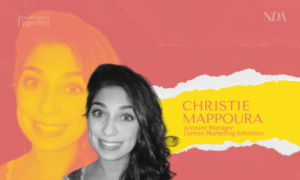These articles have been written by the first cohort of the Practice Makes Unperfect programme – a course that helps women find and finesse their public voices.
By Beckie Underwood, Head of Studio, Azerion UK
A cocktail of over-regulation and underwhelming creative means the digital industry is facing a bland crisis. Here’s what we can do to put it right..
Digital Advertising is held more accountable than any other media platform. We’re expected to be the quickest, most transparent and cheapest whilst also being scrutinised for brand safety, audience relevance, viewability and file weights.
Oh, and everything has to be new, as well. A media first!
Digital practitioners must continuously invent new technology, capabilities and formats to be seen as innovative; a new shape of box every five minutes. But when was the last time you remembered the dimension of an ad?! The most memorable ads are those that make us feel warm; that challenge prejudice; that entertain, inspire, amuse or perplex.
These ads are also the most effective for clients. An emotional connection helps consumers ‘Think, Feel and Behave’ more positively towards a brand – the objective of most clients after all.
However, this is difficult to achieve when you consider digital creative is often last on the list to consider. Digital studios are left to re-purpose rather than create from scratch, so I can see why some practitioners are turning to creative automation (an oxymoron if ever I heard one).
If we want digital to be awarded more creativity autonomy, we need to up our influence. Here’s three ways you can up your game in this space.
A Fair Start to the Race
So much creative centres on the 30” TV spot; a risk, considering it’s one of the most difficult and costly forms of media to change if you get it wrong. This is why digital should get a chance to go first.
Getting the brand message right has been critical in 2020 and something we at Collective have been focused on for our brands, whether that’s been testing tone of voice with an audience panel, exploring relevant digital experiences such as virtual showrooms and conversational ads or by running A/B/C creative test campaigns. Digital display can offer creative insights for the rest of your ad campaign, before you invest heavily in the bigger stuff.
Try a New Environment
With the 2020 lockdown digital gaming has gone kaboom as people frantically seek new entertainment and stress relief! The range in demographics is vast and initiatives like the IAB’s upcoming ‘Guide to Gaming’ project add to the belief that 2021 will be labelled the ‘Year of Gaming’. Whilst the games themselves are fun, ironically the ads surrounding them sadly are not. A user is unlikely to be guilt tripped into buying health insurance from a teeny, tiny cluttered 320×50. The gaming audience are in a positive state of mind here, so well timed brands ads should enterprise on this feeling, possibly including gamification for fun and relevancy too. Collective has recently been bought by European gaming giant, Azerion who have 15,000 games to their name in the UK and I can’t wait to help up the ad standards in this space in 2021.
The Human Touch
Digital creative is becoming impersonal and unnatural. The Coalition for Better Ad guidelines, Google intervening with their Heavy Ads policy AND soon to come, Content Layout Shift Scoring in 2021 means some teams are ‘playing it safe’ and resorting to creative automation. However, when we automate creativity to make our jobs faster, we’re losing out on original ideas and cultural influence. The ads get leaner not just in terms of file weight (obvs a good thing) but leaner also in terms of effort and innovation (obvs a bad thing).
You ought to show you care before touching a client’s brand assets (ooer). Perhaps everyone should take a leaf out of the book of entertainment clients: by far the most enthusiastic (and human!) of briefers. At the beginning of the process it’s common for entertainment brands to get everybody in the room, passionately narrate the plot, the characters, the audience, and then empower their partners to come up with the best ideas.
Starting the creative process with a conversation rather than an entry on a briefing form. Knowing the brand challenge and deciding on how you’d like the customer to experience the ad makes for a more successful campaign. My favourite example of this is a campaign we’ve recently built for Disney+ for the movie ‘Soul’. Yes, it ticks the boxes to showcase the trailer and artwork but as an added delightful experience for users we’ve added a piano! This is relevant to the film’s central character, Joe and his love for music.
Something as humans we can share but technology can’t. Technology is useful but we need to remember we are humans connecting to other humans.










